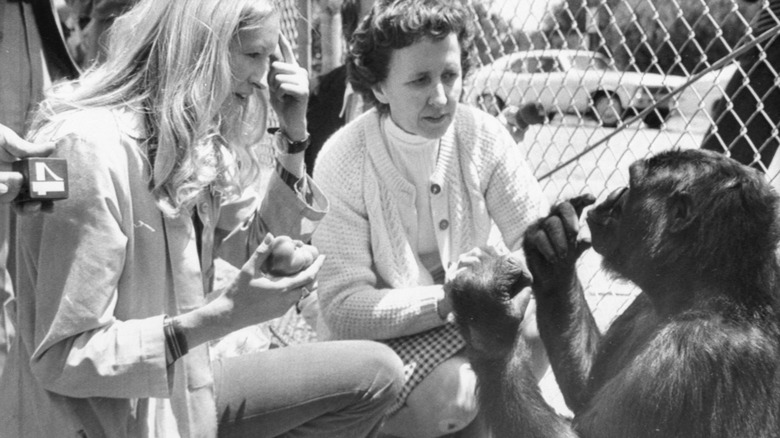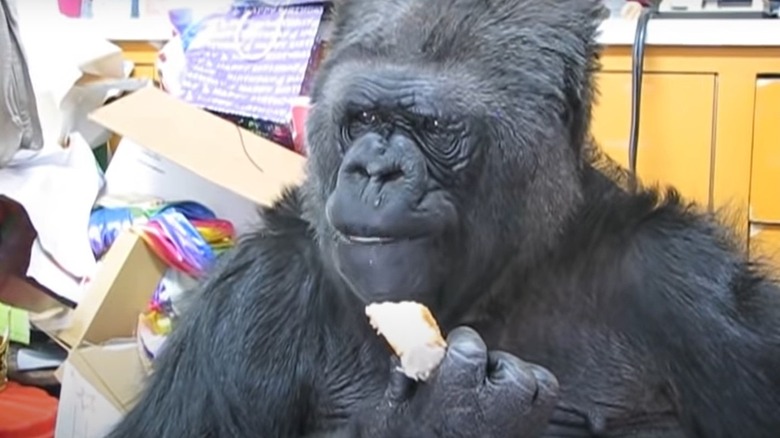This Is Where Koko The Gorilla Is Buried
Even those who don't know the specifics of Koko the gorilla's story have likely heard of her, or will recognize footage of her playing with Mr. Rogers or Robin Williams. Koko, born July 4, 1971, not only learned over 1,000 words in American Sign Language (ASL) but understood 2,000 spoken English words, as ABC News recounts. Raised and taught by Francine "Penny" Patterson, who met Koko after she had taken ill as a baby, the western lowlands gorilla went on to become an avatar of her species and spokesperson for the natural world. She loved kittens, ate vegetables out of Tupperware, was critical of her own artwork, and warned humanity about not protecting the planet. And in 2018, she died in her sleep at the age of 46. As ABC News says, her final words were simply "patient" and "old."
Koko was born in the San Francisco Zoo and spent her life in the Gorilla Foundation in Santa Cruz, California. Penny Patterson's initial work with Koko in 1972 led to the foundation's creation, which exists to this day and has extended its operations to incorporate educational, research, and public outreach-driven projects. As ABC News says, Koko died where she lived, and was buried in the foundation's animal sanctuary in Woodside, California. At present, well-wishers can leave digital flowers for Koko on Find a Grave. "Thank you Koko," one visitor writes. "You taught so many the true meaning of 'humanity' and demonstrated a sincerity I yet aspire to."
All gorillas are Kokos
Koko and Penny Patterson's unique relationship drove Project Koko, the "longest interspecies communication study in history," as the Gorilla Foundation's About Us page states. When Penny met Koko in 1971 she was a Ph.D. candidate doing her dissertation in developmental psychology at Stanford University. Koko — whose full name is Hanabi-ko, or "fireworks child" in Japanese — had been abandoned by her mother after getting sick. Penny found the "tiny, undernourished baby gorilla," as the Gorilla Foundation's Koko page says, and took her under her wing.
One year later, per the Gorilla Foundation's History page, Penny started "Project Koko," which by 1976 would blossom into the Gorilla Foundation. While Koko remained the focus of Penny's energy and the overall endeavor, the foundation turned towards conservation efforts as a whole. Two male gorillas — Michael and Ndume — joined the foundation in 1976 and 1991, respectively. Both were originally intended to be Koko's mates. No coupling happened between the gorilla's but Koko and Michael enjoyed a "sibling" type relationship until Michael died in 2000. After Koko then died in 2018 the Cincinnati Zoo requested that Ndume be returned to their facility from the Gorilla Foundation's private sanctuary, where he'd spent the 27 years prior, as the Gorilla Foundation's Ndume page states.
All the while Koko grew in popularity amongst the general public. She subverted expectations about what "huge, scary" monsters gorillas are supposed to be, as the Gorilla Foundation's Koko page says — same as she subverted Penny's own expectations about her future, lifelong companion. Hence the Gorilla Foundation's assertion that "all gorillas are Kokos."
Continuing to inspire
It's no accident that Koko captured the minds and hearts of people across the world, as she continues to do to this day. Videos like that on National Geographic show Koko signing her thoughts, feelings, and wants in a way that render interpretation unnecessary. With Koko there was no need to look at a wagging tail and infer, "Oh, this animal is feeling friendly and wants something" — Koko communicated directly with people using one of humanity's own languages. In so doing, Koko showed us that animals like her are privy to an entire, inner, self-aware world. As professor of anthropology Barbara King said on National Geographic, "Koko could show us what all great apes are capable of: reasoning about their world, and loving and grieving the other beings to whom they become attached." King was speaking at that moment of Koko grieving the losses of her friend and fellow gorilla Michael and her cat, "All Ball."
These reasons and more make it clear why folks leave virtual flowers for Koko on Find a Grave, often every few days or so. After Koko died, her caretaker and teacher Penny Patterson said on ABC News, "She had opportunities to show her brilliance and that's what we saw. We saw a person, really. She had all the attributes of a person and then some." As National Geographic says, Koko had a typically pithy answer when asked what happens to gorillas when they die. She simply said, "Comfortable hole bye."


